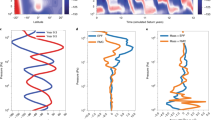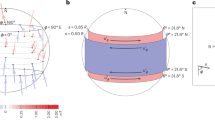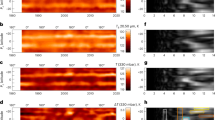Abstract
The middle atmospheres of planets are driven by a combination of radiative heating and cooling, mean meridional motions, and vertically propagating waves (which originate in the deep troposphere). It is very difficult to model these effects and, therefore, observations are essential to advancing our understanding of atmospheres. The equatorial stratospheres of Earth and Jupiter oscillate quasi-periodically on timescales of about two and four years, respectively, driven by wave-induced momentum transport1,2,3,4,5. On Venus and Titan, waves originating from surface–atmosphere interaction and inertial instability are thought to drive the atmosphere to rotate more rapidly than the surface (superrotation). However, the relevant wave modes have not yet been precisely identified. Here we report infrared observations showing that Saturn has an equatorial oscillation like those found on Earth and Jupiter, as well as a mid-latitude subsidence that may be associated with the equatorial motion. The latitudinal extent of Saturn’s oscillation shows that it obeys the same basic physics as do those on Earth and Jupiter. Future highly resolved observations of the temperature profile together with modelling of these three different atmospheres will allow us determine the wave mode, the wavelength and the wave amplitude that lead to middle atmosphere oscillation.
This is a preview of subscription content, access via your institution
Access options
Subscribe to this journal
Receive 51 print issues and online access
$199.00 per year
only $3.90 per issue
Buy this article
- Purchase on SpringerLink
- Instant access to full article PDF
Prices may be subject to local taxes which are calculated during checkout



Similar content being viewed by others
References
Andrews, D. G., Holton, J. R. & Leovy, C. B. Middle Atmosphere Dynamics (Academic, New York, 1987)
Baldwin, M. P. et al. The quasi-biennial oscillation. Rev. Geophys. 39, 179–230 (2001)
Leovy, C. B., Friedson, A. J. & Orton, G. S. The quasiquadrennial oscillation of Jupiter’s equatorial stratosphere. Nature 354, 380–382 (1991)
Friedson, A. J. New observations and modelling of a QBO-like oscillation in Jupiter’s stratosphere. Icarus 137, 34–55 (1999)
Flasar, F. M. et al. An intense stratospheric jet on Jupiter. Nature 427, 132–135 (2004)
Barnet, C. D., Beebe, R. F. & Conrath, B. J. A seasonal radiative-dynamic model of Saturn’s troposphere. Icarus 98, 94–107 (1992)
Bézard, B. & Gautier, D. A seasonal climate model of the atmospheres of the giant planets at the Voyager encounter time. I. Saturn’s stratosphere. Icarus 60, 296–310 (1985)
Conrath, B. J., Gierasch, P. J. & Leroy, S. S. Temperature and circulation in the stratosphere of the outer planets. Icarus 83, 255–281 (1990)
Moses, J. I. & Greathouse, T. K. Latitudinal and seasonal models of stratospheric photochemistry on Saturn: Comparision with infrared data from IRTF/TEXES. J. Geophys. Res. 110, 09007 (2005)
Flasar, F. M. et al. Exploring the Saturn system in the thermal infrared: The Composite Infrared Spectrometer. Space Sci. Rev. 115, 169–297 (2004)
Flasar, F. M. et al. Temperatures, winds, and composition in the Saturnian system. Science 307, 1247–1251 (2005)
Greathouse, T. K. et al. Meridional variations of temperature, C2H2 and C2H6 abundances in Saturn’s stratosphere at southern summer solstice. Icarus 177, 18–31 (2005)
Orton, G. S. et al. Thermal maps of Jupiter: Spatial organization and time dependence of stratospheric temperatures, 1980 to 1990. Science 252, 537–542 (1991)
Simon-Miller, A. A., Poston, B. W., Orton, G. S. & Fisher, B. Wind variations in Jupiter’s equatorial atmosphere: A QQO counterpart? Icarus 186, 192–203 (2007)
Orton, G. S. et al. Semi-annual oscillations in Saturn’s low-latitude stratospheric temperatures. Nature doi: 10.1038/nature06897 (this issue)
Lindzen, R. S. & Holton, J. R. A theory of the quasi-biennial oscillation. J. Atmos. Sci. 25, 1095–1107 (1968)
Holton, J. R. & Lindzen, R. S. An updated theory for the quasi-biennial cycle of the tropical troposphere. J. Atmos. Sci. 29, 1076–1080 (1972)
Gray, L. J. & Pyle, J. A. A two-dimensional model of the quasi-biennial oscillation in ozone. J. Atmos. Sci. 46, 203–220 (1989)
Dunkerton, T. J. Nonlinear propagation of zonal winds in an atmosphere with Newtonian cooling and equatorial wavedriving. J. Atmos. Sci. 48, 236–263 (1991)
Li, X. & Read, P. L. A mechanical model of the quasi-quadrennial oscillation in Jupiter’s stratosphere. Planet. Space Sci. 48, 637–669 (2000)
Beebe, R. F., Barnet, C., Sada, P. V. & Murrell, A. S. The onset and growth of the 1990 equatorial disturbance on Saturn. Icarus 95, 163–172 (1992)
Sanchez-Lavega, A. Observations of Saturn’s Ribbon Wave 14 years after Its discovery. Icarus 158, 272–275 (2002)
Achterberg, R. K. & Flasar, F. M. Planetary-scale thermal waves in Saturn’s upper troposphere. Icarus 119, 350–369 (1996)
Schinder, P. J. et al. Vertically propagating waves in the upper atmosphere of Saturn from Cassini radio occultations. (AGU Fall Meeting Abstract No. P23D-06, 2005)
Author information
Authors and Affiliations
Corresponding author
Supplementary information
Supplementary Information
The file contains Supplementary Notes, Supplementary Table 1 and Supplementary Figures 1-2 with Legends. (PDF 396 kb)
Rights and permissions
About this article
Cite this article
Fouchet, T., Guerlet, S., Strobel, D. et al. An equatorial oscillation in Saturn’s middle atmosphere. Nature 453, 200–202 (2008). https://doi.org/10.1038/nature06912
Received:
Accepted:
Issue date:
DOI: https://doi.org/10.1038/nature06912
This article is cited by
-
An intense narrow equatorial jet in Jupiter’s lower stratosphere observed by JWST
Nature Astronomy (2023)
-
Joint evolution of equatorial oscillation and interhemispheric circulation in Saturn’s stratosphere
Nature Astronomy (2022)
-
Unexpected long-term variability in Jupiter’s tropospheric temperatures
Nature Astronomy (2022)
-
Fluctuations in Jupiter’s equatorial stratospheric oscillation
Nature Astronomy (2020)
-
Cassini Exploration of the Planet Saturn: A Comprehensive Review
Space Science Reviews (2020)



